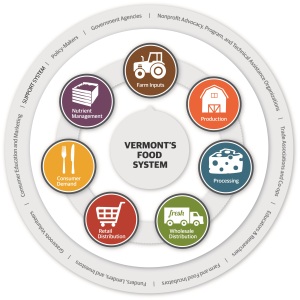The Mad Farmer, Flying the Flag of Rough Branch, Secedes from the Union
February 5, 2015Ello, Vermont? (#SOCIALMEDIAREV)
February 6, 2015Vermont Gets Real About Local Food, by Rachel Carter (FARM-TO-PLATE)
Local food movements are trending across the country. For some, it’s the next “in” thing to do, but for many Vermonters, supporting local agriculture has been a way of life long before it was trendy.
So where does the term “food system” fit in when talking about local food? Everyone from academics to government officials are referring more to food systems when discussing sustainable agriculture, the future of farms, how to feed our growing population, and food equity challenges.
 Also referred to geographically as a food shed, the food system includes all components of how food is produced and distributed—everything from farm viability and labor costs to consumer demand and food access to education and energy.
Also referred to geographically as a food shed, the food system includes all components of how food is produced and distributed—everything from farm viability and labor costs to consumer demand and food access to education and energy.
Our current food system is out of balance. We are far too reliant on food grown and distributed outside of our region and decisions made outside of our control. Even in locally conscious Vermont, only an estimated 5% of the food consumed by Vermonters is actually produced here.
There are seven core areas that comprise the food system and all of them need to be working in harmony together to successfully relocalize Vermont’s food system.
- Nutrient management is the effective use of nutrients–primarily nitrogen, phosphorus and potassium—from food waste, livestock manure, cover crops, and synthetic fertilizer to other amendments that minimize negative impacts of nutrient losses on the environment while providing sufficient nutrients for crop and animal growth throughout their life cycles.
- Farm inputs are resources such as land, soil, fertilizer, animal feed, seed, labor, equipment, and energy that are essential for food production. Inputs are the expenses of a farm, and so changes in input costs have a significant effect on the viability of a farm.
- Production is the actual activity of growing and raising food which includes different scales of production (e.g., small, medium, large) for different markets (direct to consumer, retail, wholesale). Major categories include dairy production, livestock grown for meat, maple syrup, fruits and vegetables, grains, honey, beer, hard cider, spirits, wine, and fish.
- Processing converts raw produce and animal products into added value food that can be transported longer distances, keep longer on store shelves, and meet consumer demands.
- Wholesale distribution is the aggregation and resale of food to institutional, commercial, and retail (e.g., restaurants and supermarkets) markets.
- Retail distribution is the selling of food direct to either consumers through CSAs, farmers’ markets, and farm stands or direct to retail locations including grocery stores, country stores, food co-ops, schools, hospitals, and restaurants.
- Consumer demand drives the marketplace. Where our food comes from and where people buy food are key variables for understanding how to boost consumer demand for local food products.
The entire state of Vermont has pulled together to develop the most comprehensive food system plan in the country to strengthen the working landscape, improve the profitability of farms and food enterprises, maintain environmental resilience, and increase local food access for all Vermonters. Known as Vermont’s Farm to Plate Initiative, the state is now in its fourth year out of ten where businesses, government, and non-profits are working together to develop Vermont’s farm and food economy that builds upon the Vermont brand and our working landscape.
Vermont’s rich agricultural heritage and traditions helped pave the way for Vermont to be a national leader in the local food movement. Embracing the past while educating ourselves on the current state of our food system will empower us to work together to grow our farm and food economy and increase access to local food for all Vermonters—both goals of Vermont’s Farm to Plate Initiative.
To build upon our role as a national leader in the local food movement, it is becoming increasingly important to support “regional” after “Vermont” as the Northeast works to define the regional food shed. Each of the New England states is participating in the “New England Food Vision”—an aspiration for New England to produce at least 50 percent of its food by 2060. The regional food system approach is what will ultimately move the dial and bring a broken system back into balance.
Learn more about how Vermont is relocalizing how food gets from farm to plate, both in our state and the region at www.VTFarmtoPlate.com.
Rachel Carter is homesteader who lives in Plainfield, Vermont. She is the communications director at the Vermont Sustainable Jobs Fund, the non-profit organization that coordinates Vermont’s Farm to Plate Initiative. She is also a journalist and recent co-author of VERMONT: An Explorer’s Guide. Follow her on Twitter and Instagram @RachelCarterPR.
Share this:
- Click to print (Opens in new window)
- Click to email a link to a friend (Opens in new window)
- Click to share on Twitter (Opens in new window)
- Click to share on Facebook (Opens in new window)
- Click to share on Reddit (Opens in new window)
- Click to share on LinkedIn (Opens in new window)
- Click to share on Tumblr (Opens in new window)
